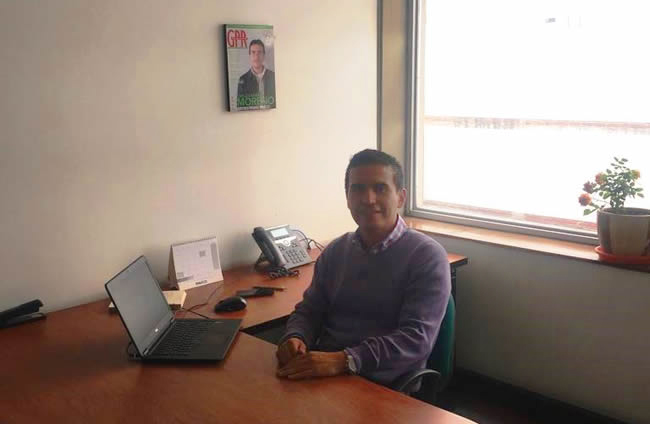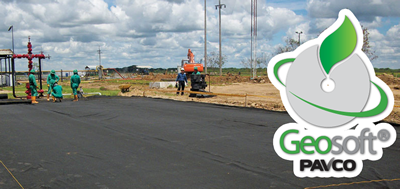Geosynthetica’s Spanish-language publication editor, Natalia Rodado Bernal, had the opportunity to interview engineer Carlos Moreno, who heads up the Geosystems Engineering Department of PAVCO. His group is focused on the technical engineering behind PAVCO’s many geosystems projects, with the company providing consulting, construction, and geosynthetics expertise in civil works.

CARLOS MORENO ON GEOSYNTHETICS IN COLOMBIA
Natalia Rodado writes:
PAVCO began looking more broadly at geotechnical engineering’s future needs about 30 years ago. Here, Carlos Moreno says, they focused on a global need to reduce the use of non-renewable resources (e.g., stone) and create more sustainable options in civil infrastructure.
Geosynthetics emerged as one of the key solutions that PAVCO directed its operations towards.
The company began manufacturing nonwoven geotextiles, and they found many uses for these materials. They also found considerable reductions in project costs, construction times, and environmental impact. These realizations helped pave the way for substantial expansion in geosynthetics both for the company and the general Colombian market.
PAVCO increased its manufacturing capabilities and, where direct manufacturing was not available within the country, facilitated the importation of other geosynthetics classes.
Constant reinvestment and development of high-quality engineering services, Carlos Moreno says, were major reasons for PAVCO’s growth. Geosynthetics have a large market, but they are only a small part of most projects and general field awareness of their handling and performance characteristics grows more slowly than the market. As such, it is important for an operation to have strong technical understanding to provide guidance and service to the engineering sectors a company serves with geosynthetics.
PAVCO, Carlos Moreno notes, has provided technical leadership in the Colombian marketplace, including providing education assistance (e.g., technical seminars), disseminating non-proprietary information on geosynthetics, and offering management and technical support around these technologies. This interaction has helped not only the company’s growth but has helped Colombia become one of the leading countries in Latin America for geosynthetics expertise.
EARLY ADOPTERS & TECHNICAL COMMUNICATION
In Colombia, as in other areas of the world, the benefits of incorporating geosynthetics into infrastructure have been proven time and again. The rate of adoption has been gradual, with ever more applications and industries opening to them.
The use of geosynthetics, Carlos Moreno says, was greeted with a lot of skepticism early on—as is common with new technologies—but that “early adopters” in the field helped lead the way and provide the key projects and awareness to open the Colombian infrastructure market to geosynthetics.
Early adopters, he notes, are important and common influencers in Latin America for bringing new technologies to wider use. These key companies and individuals help build trust and provide examples for others.
Beyond the importance of early adopter influence in Latin America, Moreno says that being able to share the technical aspects, to explain them to others, is essential. It has been fundamental for PAVCO, he says, to help break skepticism.
As such, being able to properly convey the technical and engineering issues to the market remains a priority within his company’s commercial policy. Geosynthetics have experienced tremendous growth in Colombia and throughout Latin America; but, many barriers remain. An effective system for technology transfer on a national engineering level, for example, is still lacking, so it is even more important for private companies to play a strong role in effectively communicating the merits of geosynthetic materials.
REGULATIONS IN COLOMBIA
Regulations have played a small role in the growth of geosynthetics in Colombia, but regulations are still not prevalent. Drainage geosynthetics and geocells in load-bearing applications (e.g., access roads) are a couple areas that in Colombia could benefit tremendously from regulatory support, as these materials and solutions offer much in terms of performance enhancements and cost savings for Colombian projects.
Another barrier to achieving truly effective regulatory support in Colombia and throughout Latin America, Moreno notes, is the need to develop or refine standards and regulations specifically for each market. Too many standards and regulations are pulled from other world areas, and in particular from the United States. This is not an indictment of US standards.
We must create our own standards, Carlos Moreno says, that adapt to our specific environmental conditions.
It is, in one way, a need to “tropicalize” the use of geosynthetics.
Certain granular materials are cited in many geosynthetics regulations, for example. But, in Central and South America, there are not simple ways to draw comparisons between US and Latin American soils and granular materials available for construction.
Colombia’s industry has worked hard to establish success stories to serve as referents to the larger industry.

STATE OF GEOSYNTHETICS EDUCATION IN COLOMBIA
As is the case elsewhere, few universities in Colombia offer geosynthetic courses and most of them are not compulsory subjects of the engineering curriculum. The current learning of geosynthetics has been mostly empirical, Moreno says, which is quite unusual given that they are materials used in all sectors of civil engineering. Training teachers to teach geosynthetics, he says, is one of the major needs so that students can enter the field with a basic knowledge of geosynthetics. Professional practice, then, can build upon that foundation.
He also notes that academia needs to be more open to interacting with industry. The perception is that industries are dedicated to sales. With geosynthetics, however, industry holds a significant amount of the technical expertise and has actively worked, nationally and internationally, to generically transfer technical knowledge.
In Colombia, though, the historical disconnect between industry and academia remains. It has slowed the dissemination of knowledge about these materials, but it is not a dire situation. Both industry and academia have made strides, and organizations such as the International Geosynthetics Society have established instructor training programs (e.g., Educate the Educators).
THE ROLE OF GEOTECHNICAL SOFTWARE
Software continues to grow in importance for modern geotechnical practice, which means that geosynthetics must be supported by proprietary and general commercial software. PAVCO has developed Geosoft, a software for the design of geosynthetics, and the company has designed it primarily for the Spanish-speaking Americas, which makes it unique among available tools.

Geosoft began as a 1998-published book focused on the generalities of geosynthetics. As design methodologies and criteria evolved and the ways in which engineers interacting with information changed, PAVCO developed spreadsheets and, later, software tools to perform essential calculations. The end result of this process was the creation of Geosoft.
THE FUTURE OF GEOSYNTHETICS IN COLOMBIA
Carlos Moreno thinks that geosynthetics in Colombia still have a lot of growth potential. In the medium and long-term, he notes, business expectations are very good. However, it is important that, as an industry, the technical and quality level supporting geosynthetic materials must continue to increase.
Transportation infrastructure, which is one of the most prominent users of geosynthetics in Colombia and in which Moreno holds considerable expertise, is a sector to watch. It reveals not only the technical strength and performance advantages of these materials but significant economic benefits.
And since Colombia has significant shortcomings in road infrastructure development, geosynthetics have a significant opportunity here, both for the general practice and for academia, which can provide research support and ensure that new engineers are aware of the latest developments in the practice.
Learn more about PAVCO’s geosynthetics expertise at the company’s website.
Follow the latest on geosynthetics in the Spanish-speaking Americas at https://www.geosynthetica.com.es.
Geosynthetica’s International Editorial Director Chris Kelsey contributed to this translation and report.











